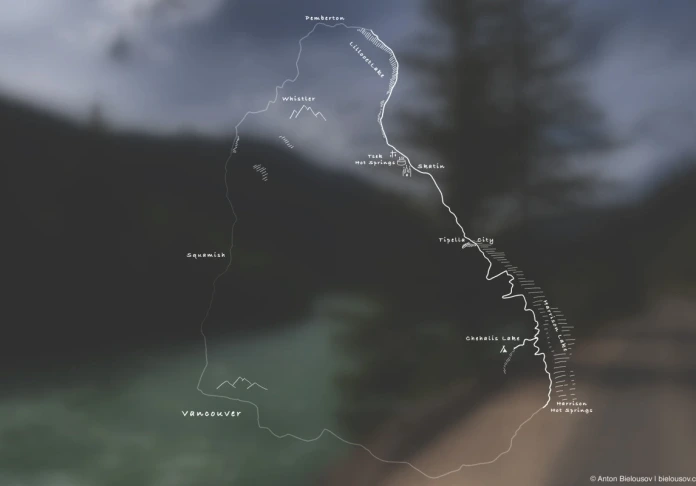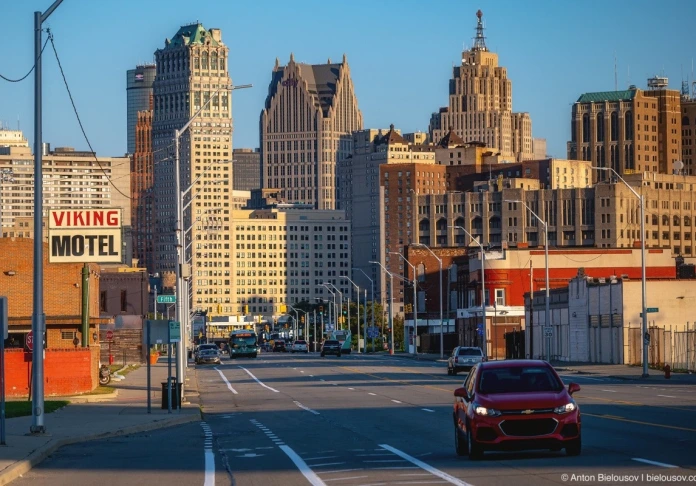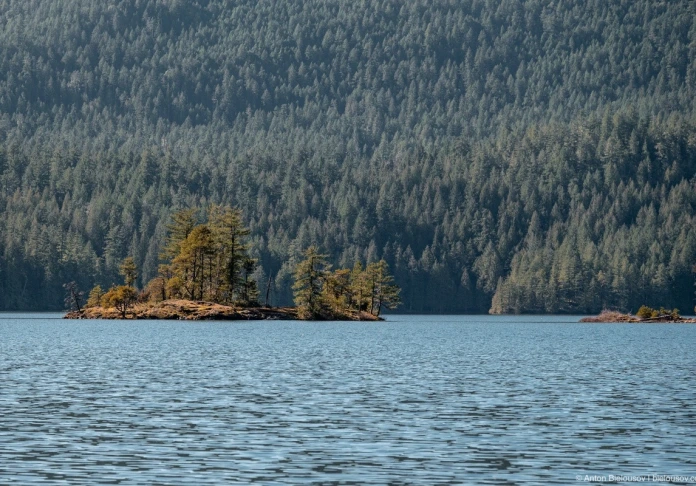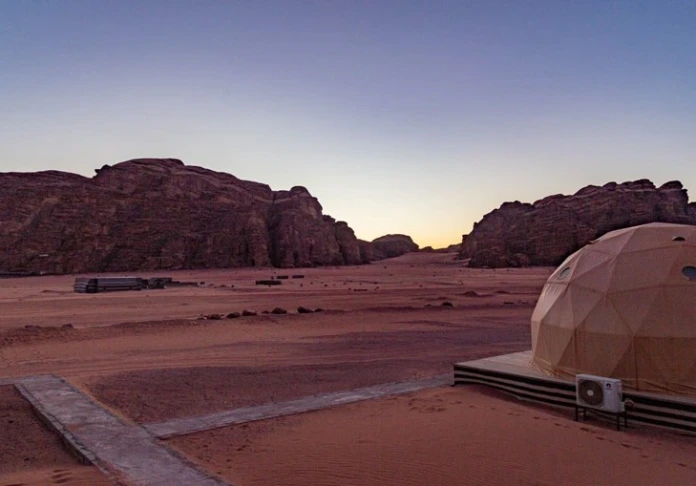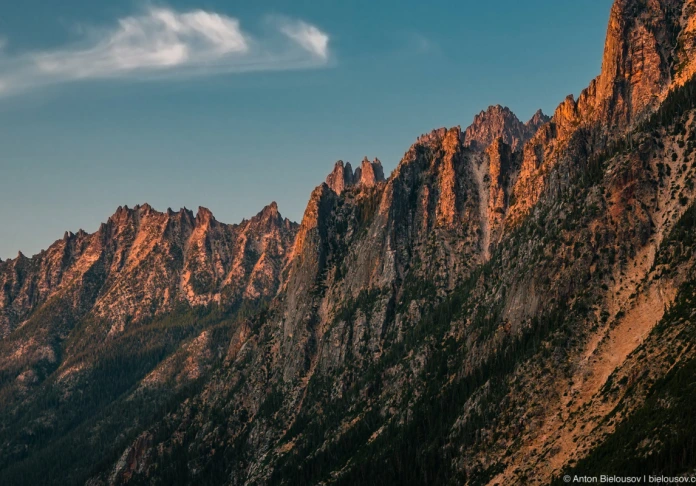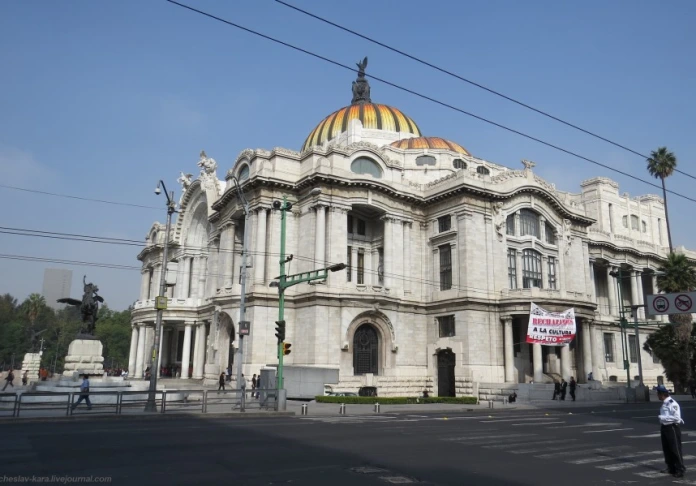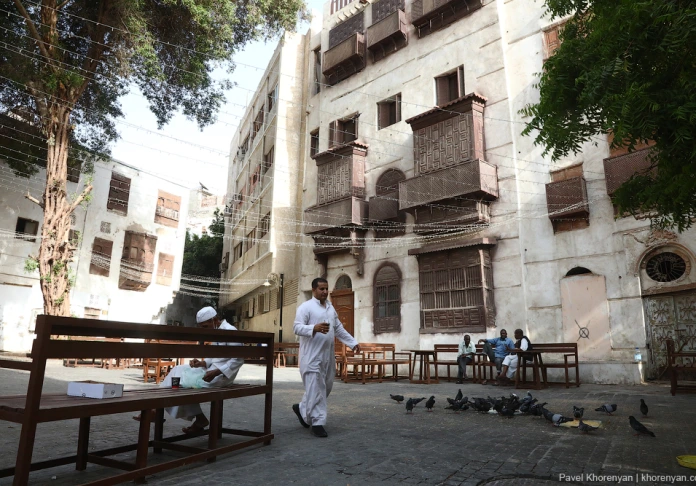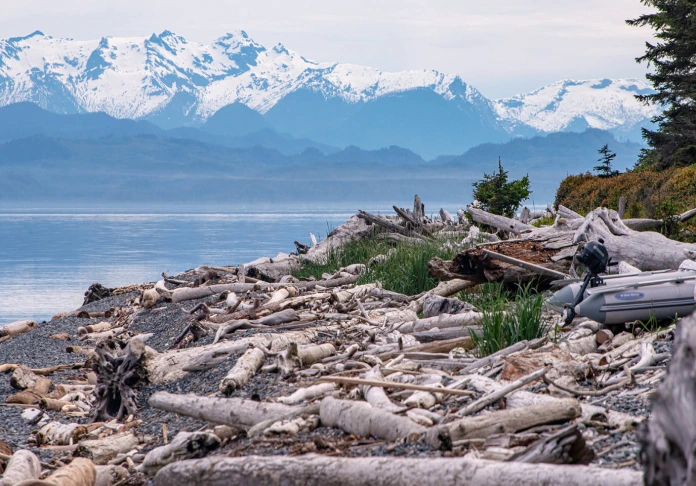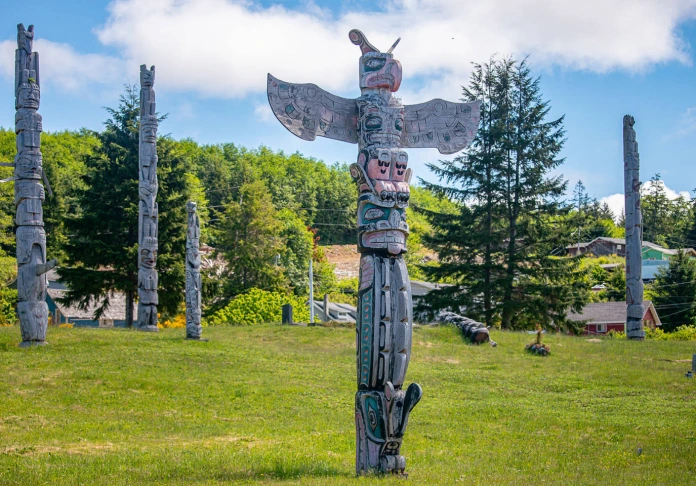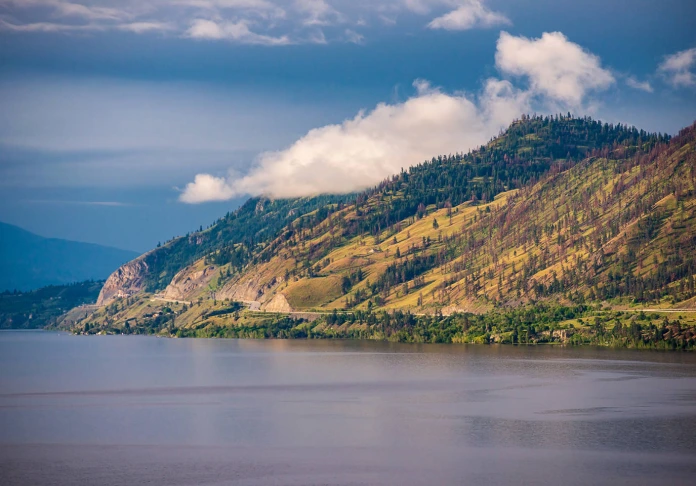Italy
Brescia is a city and a fortress.
The city of Brescia is located in northern Italy, in the foothills of the Alps, roughly halfway between Milan and Verona. It is not as popular in terms of tourism as its famous neighbors, but there are many sights and ancient monuments preserved here, so a walk in Brescia is like a journey through time - from one historical era to another.
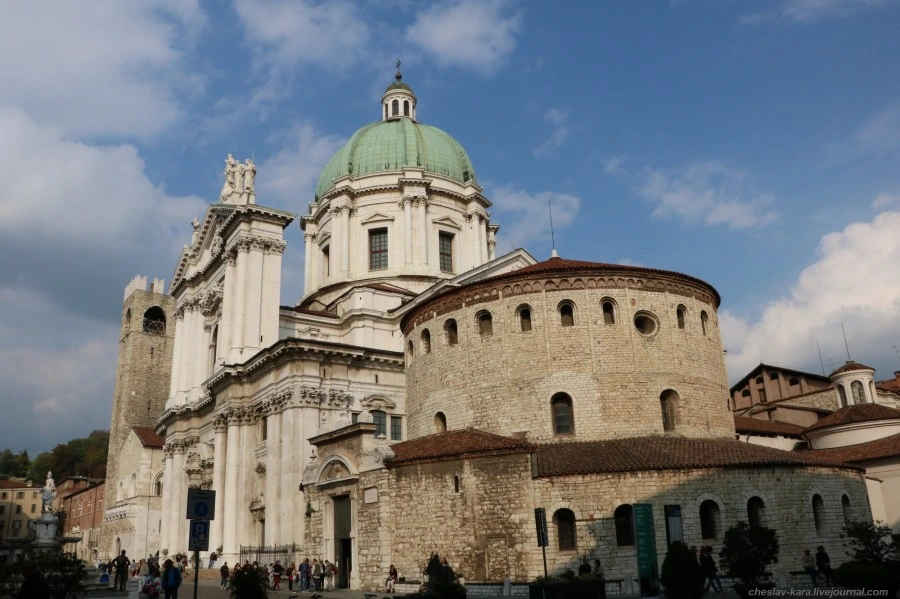
Further 38 photos (October 2019):
Brescia was founded a long time ago, no later than 350 BC, flourished in the era of Ancient Rome, in the Middle Ages, like most northern Italian cities, the history had a turbulent history, often passing from one ruler to another. From the 15th to the 19th century, Brescia was owned by the Venetians. In 1799 it was taken by storm by the troops of Suvorov, but after the Napoleonic wars the city fell to the Austrians, who were heroically driven out by Garibaldi in 1859.
Now the population of Brescia is about 200 thousand people, it is the second largest city in Lombardy after Milan.
We start as usual from the station. Its building is stylized as a fortress: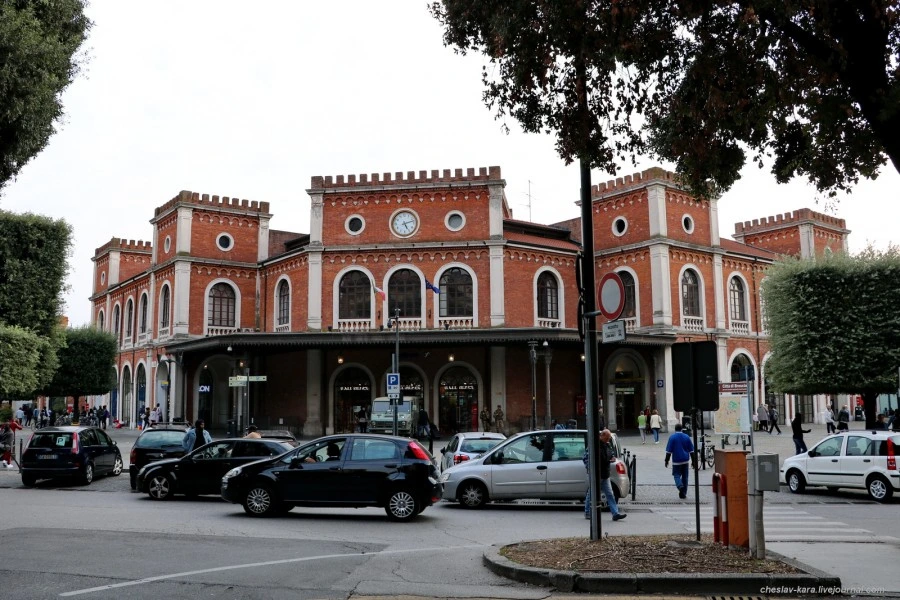
Brescia has many churches with beautiful interiors. It is unrealistic to get around everything in one day, and there is no way to tell about everything in one post either. Therefore, alas, some attractions will have to be sacrificed.
The first church on our way is St. Francis of Assisi (). The building of the church and monastery was erected in the 13-14th centuries. As usual, the outside looks pretty simple: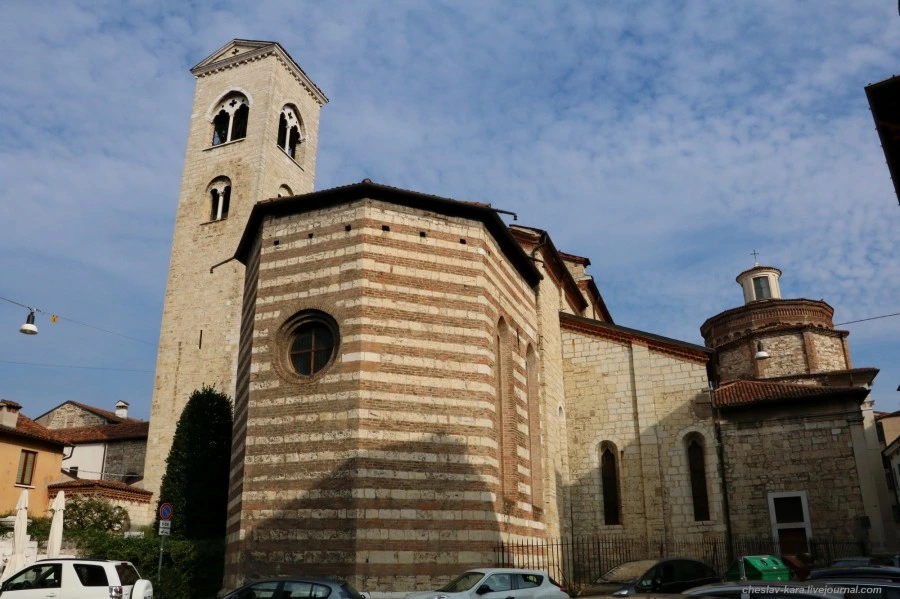
Initially (in the 14th century) all the walls and ceiling of the church were covered with frescoes. Unfortunately, most of them have been lost, so that the interior at first glance seems simple and austere, as St. Francis bequeathed: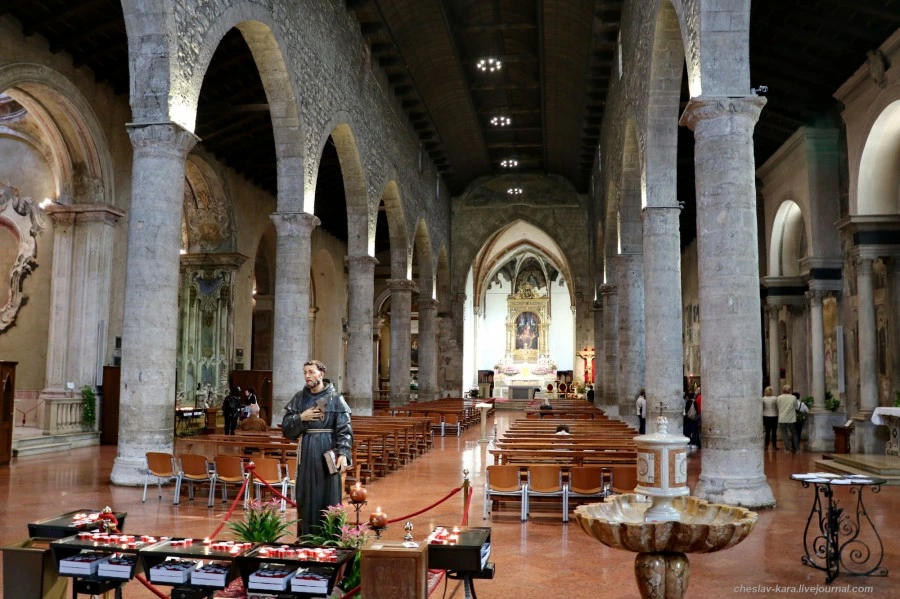
However, walking to the middle of the church and turning left, you can see a real gem in the Baroque style - (Chapel of the Immaculate Virgin).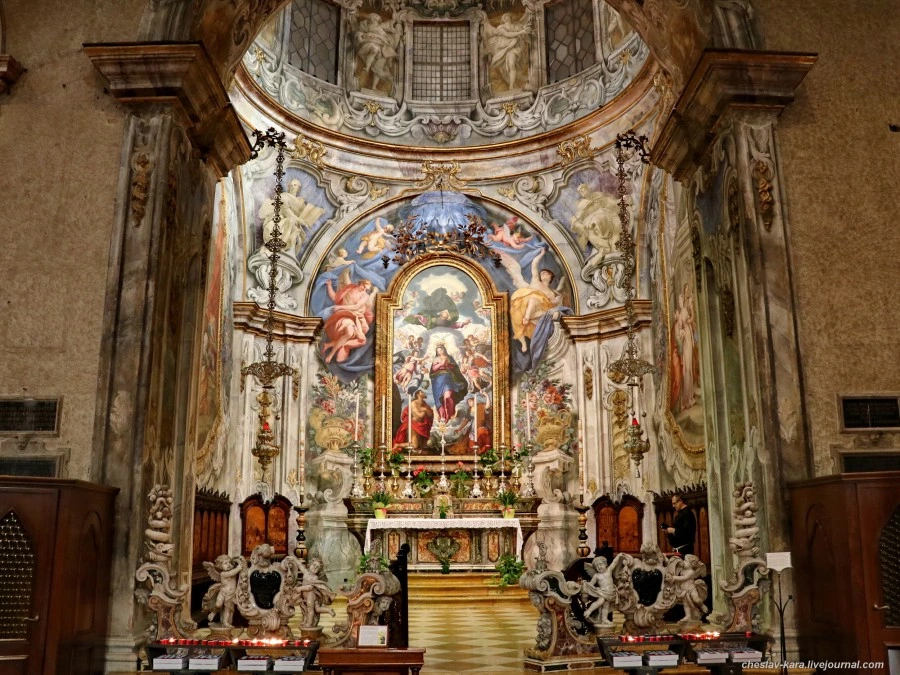
Its interior belongs mainly to the 17-18 centuries.
There is also a small church of Santa Maria dei Miracoli () nearby . Here, attention should be paid to the stone carvings that adorn both the facade and the interior:
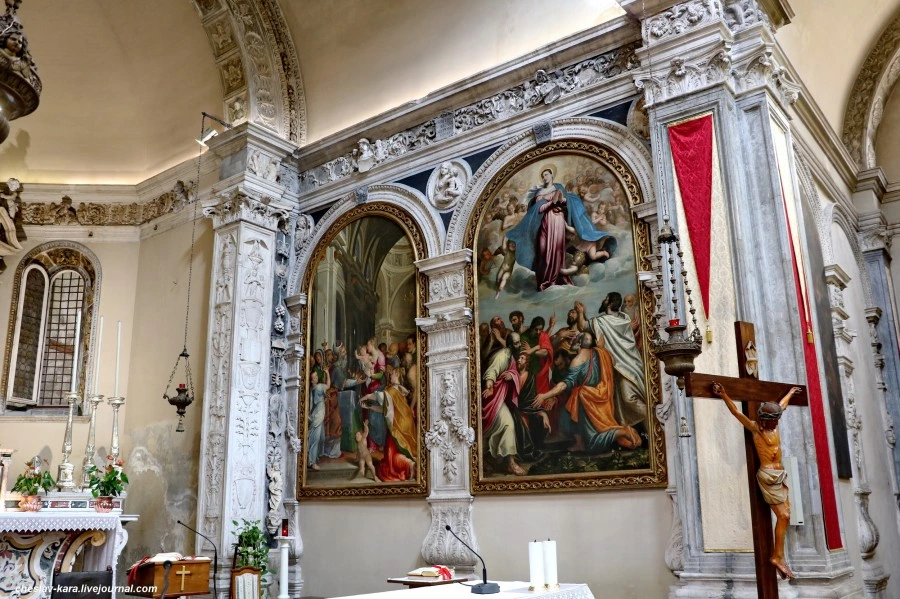
Typical streets of the historic city center: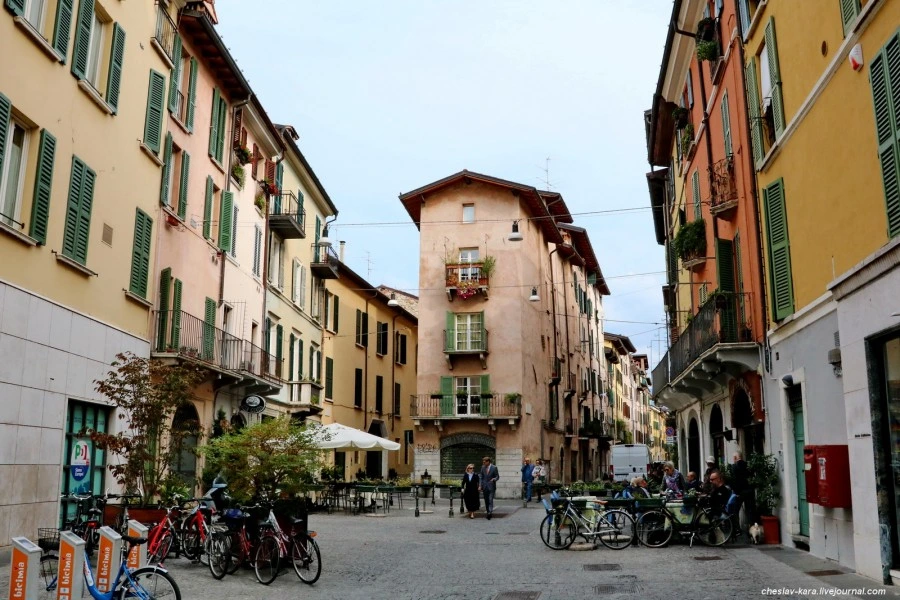
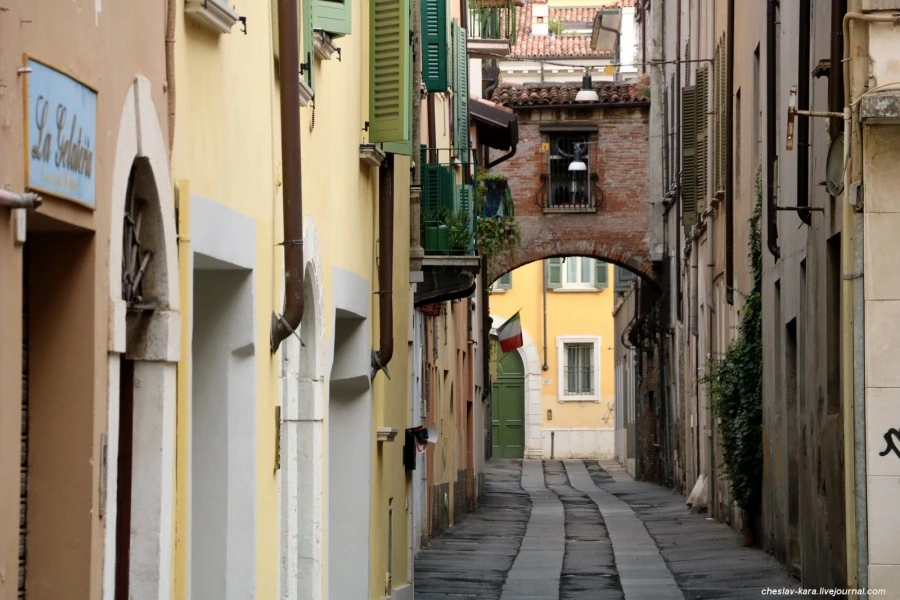
Tower of Torre della Pallata . Built in 1254, later added a clock and a fountain in the form of two streams, symbolizing the main rivers of Lombardy - Mella and Garza: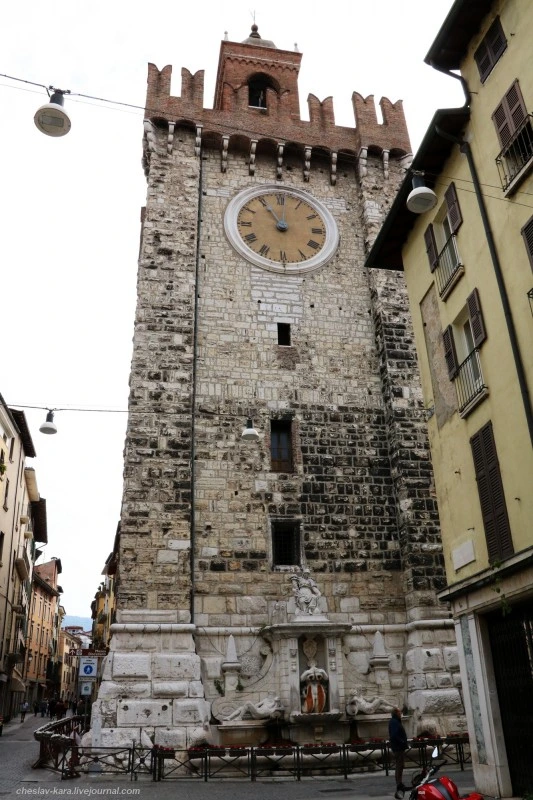
Street Garibaldi (Corso Giuseppe Garibaldi):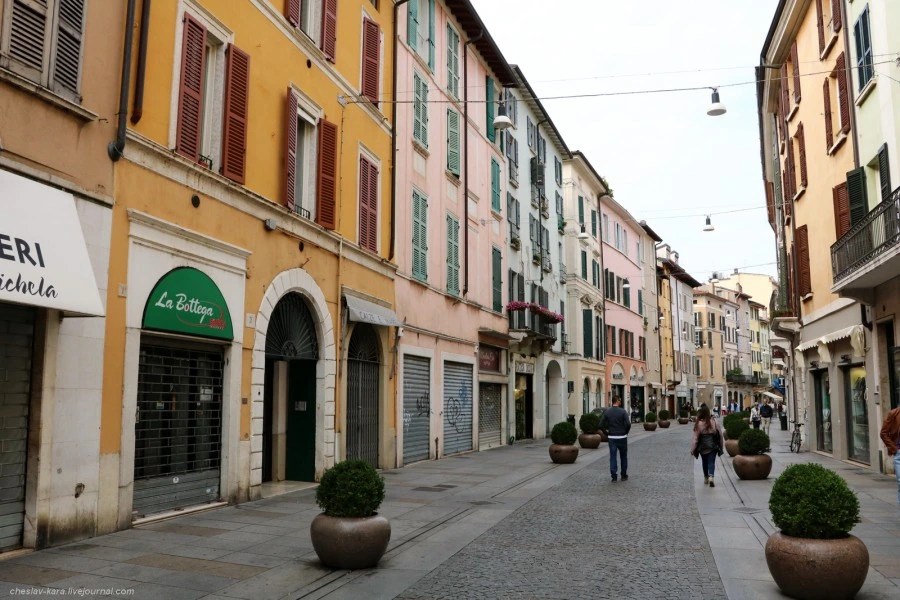
The three central squares of Brescia are next to each other. The most modern of them, reminds of the times of Mussolini. Here, in particular, is the first skyscraper in Italy - Torrione INA . This 13-storey building with a height of 57 meters was completed in 1932 and was the tallest in Italy until 1934.
The arches around the windows were supposed to resemble the Colosseum, according to the architects: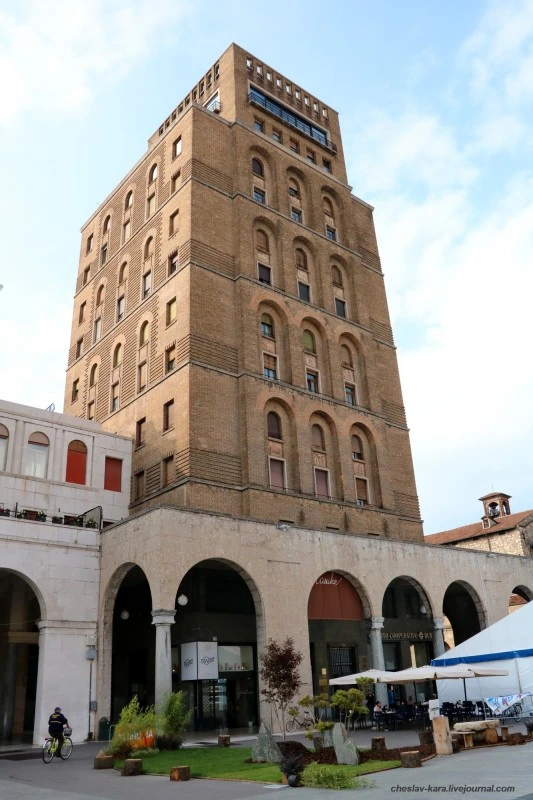
The Renaissance is symbolized by the Piazza della Loggia (). It was formed in the 15-16th centuries, during the period when Brescia was part of the Venetian Republic.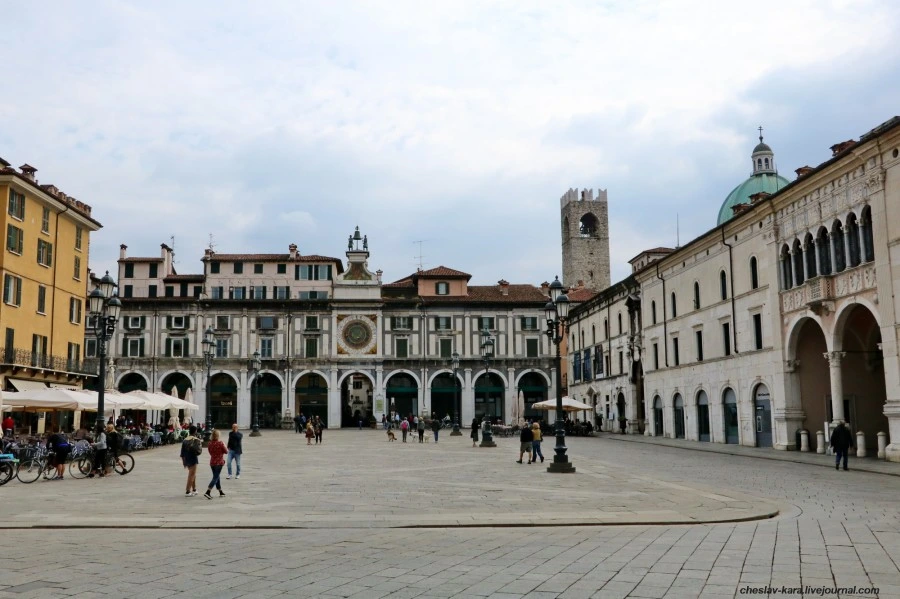
The clock is very similar to the one installed in Venice in St. Mark's Square.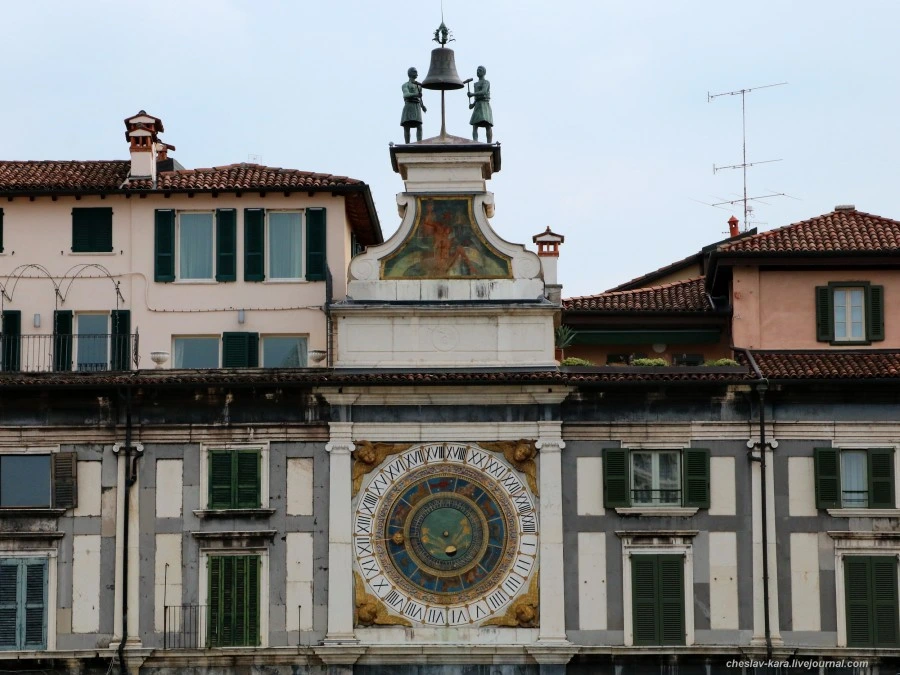
In the fashion of that time, the dial is 24-hour, in addition, they display the phases of the moon, calendar, zodiac and other relevant information: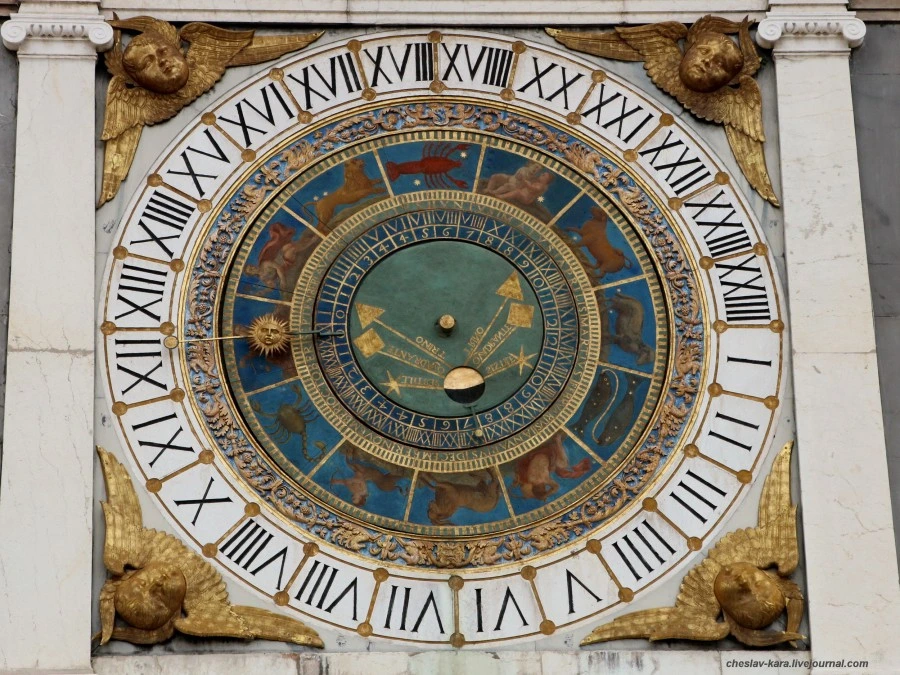
On the opposite side of the square is the Palazzo della Loggia (). The palace was built for the city authorities in 1492-1572.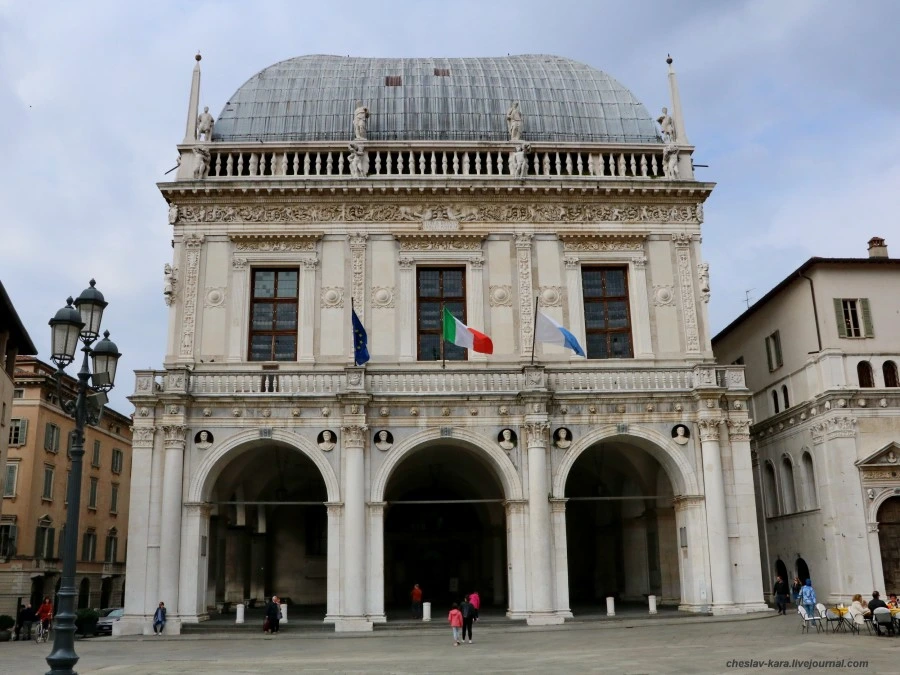
Despite the fact that this is a functioning administrative building, in principle, you can go inside (unless there are any official events held there) and admire the wonderful interiors.
The third of the central squares is Piazza Duomo (aka)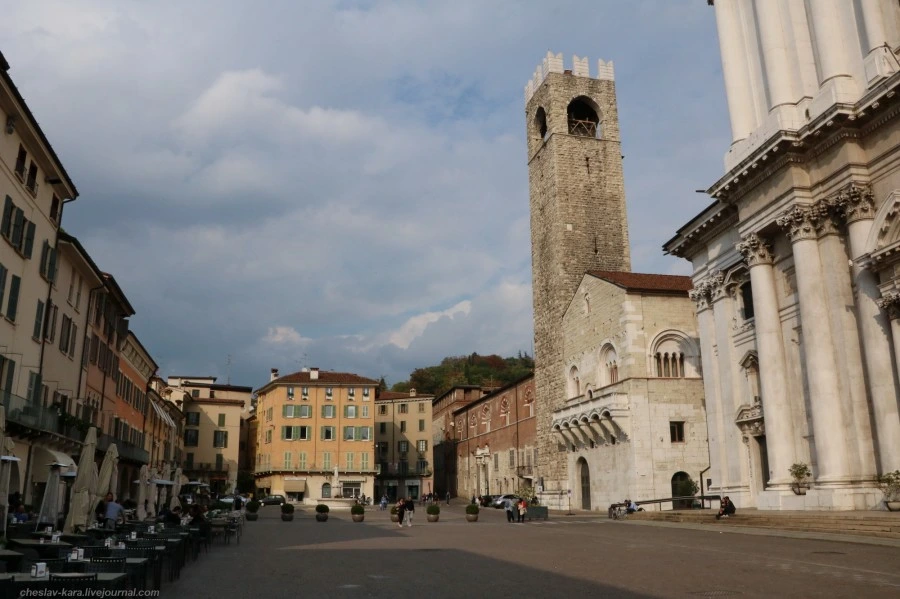
On the right, you can see the tower ("People's Tower") and the palace (a complex of buildings of the 12-13th centuries used by the city administration).
There are two cathedrals (Duomo) - New and Old.
The construction of the new Cathedral (aka) began in 1604, and was finished only in 1825. It is, of course, large, impressive, but - some boring one. Both outside and inside, it is made in one and only color - white.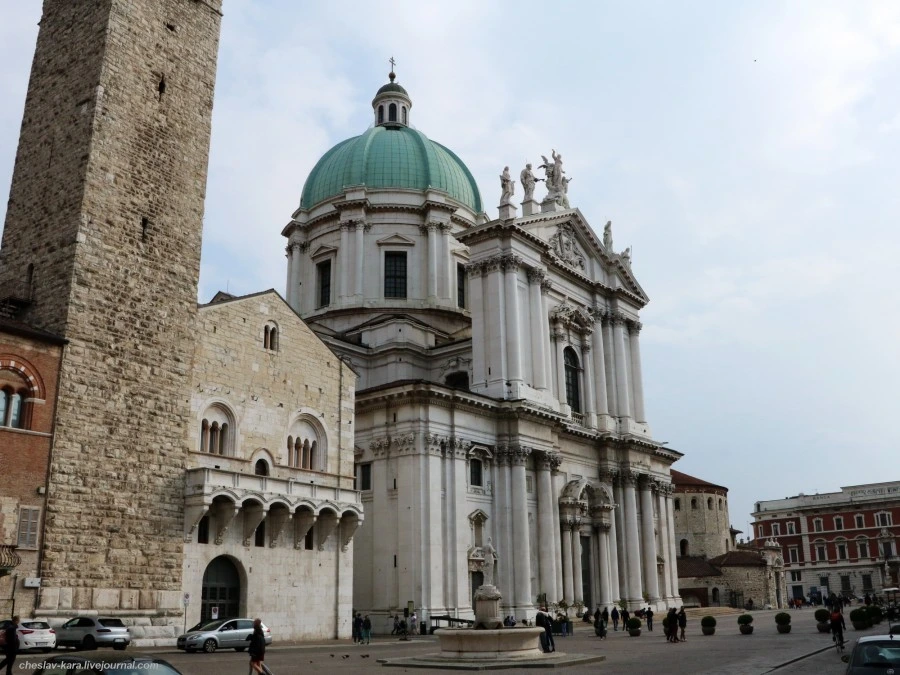
Nearby is the Old Cathedral (), also called because of its round shape. Built in the 11th century on the site of an early Christian basilica.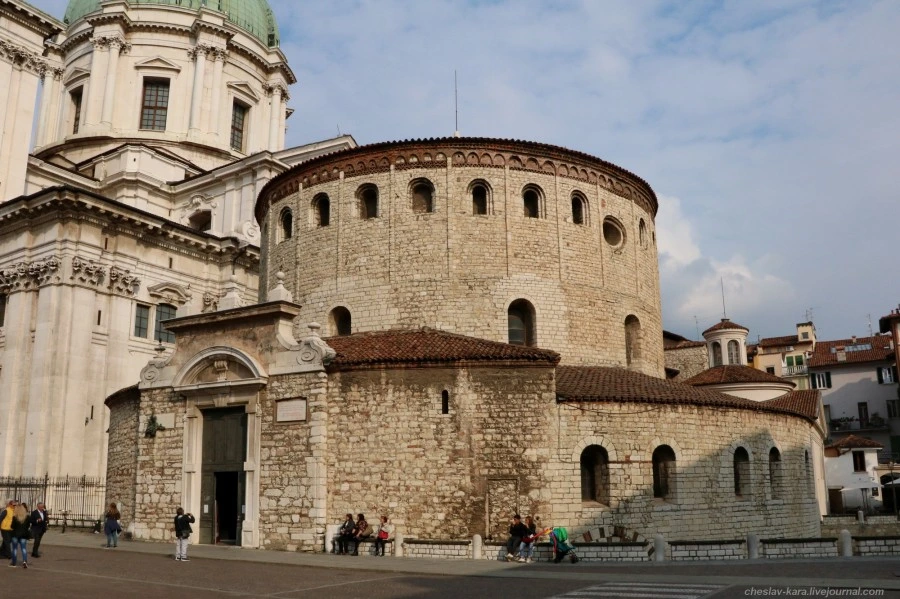
Inside, the Old Cathedral consists of two very dissimilar parts. The first is round, completely devoid of any decorations, in the austere spirit of early Christianity: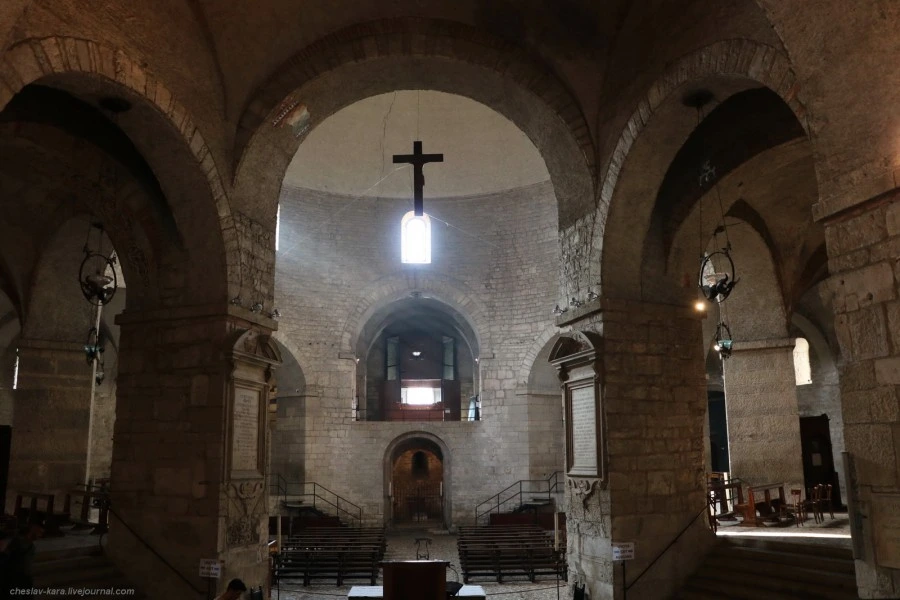
At the back, a rectangular transept with an altar and two chapels on the sides, built in the 14th century, adjoins the round rotunda.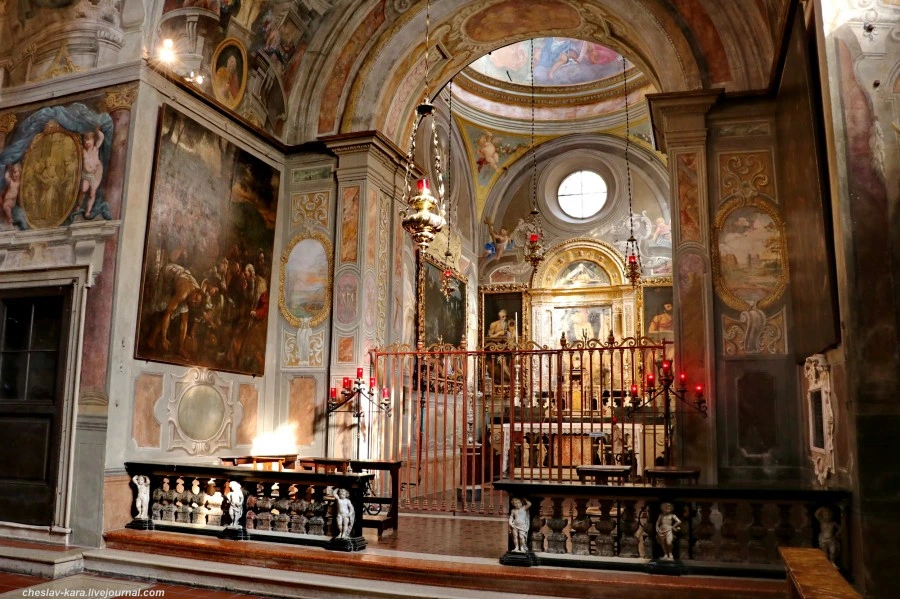
And this "rectangular" part of the cathedral is richly decorated with Baroque works of the 16-17 centuries: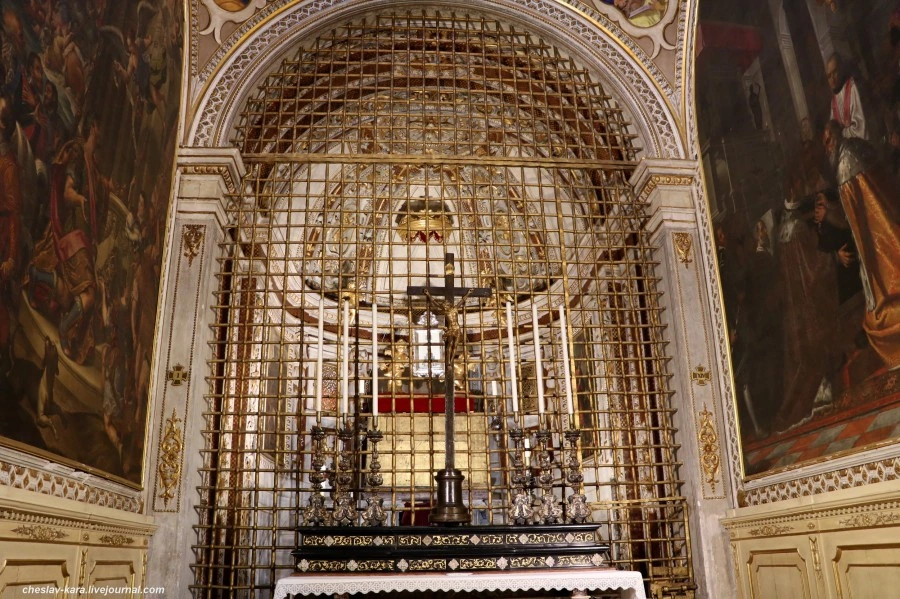
Go ahead.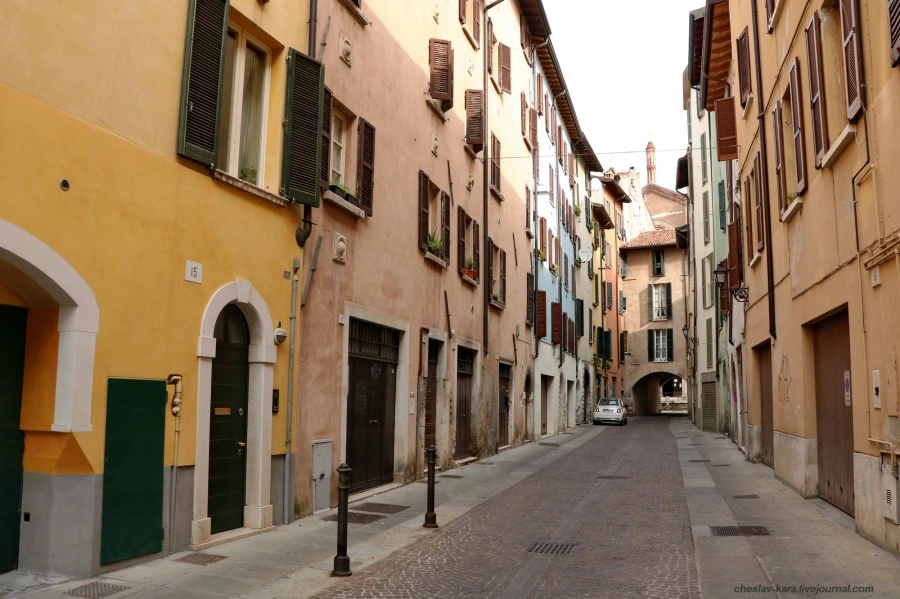
In Brescia, the ruins of the ancient Roman Capitoline temple () and a theater () are preserved :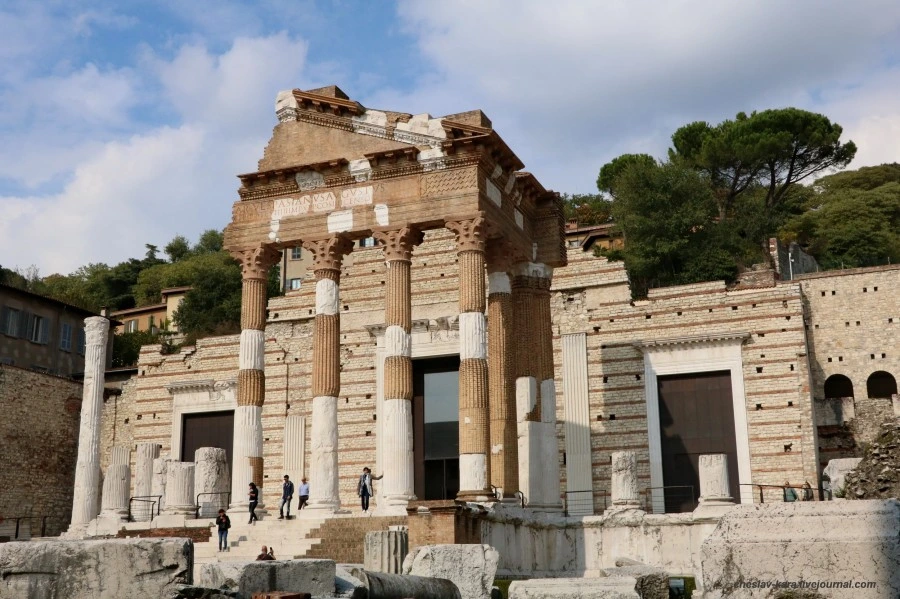
The entrance to the Capitol is paid, the theater is free.
Behind these ruins, a little further along Via dei Mesei, on the territory of a former monastery, there is a museum complex. It includes the archaeological and art museums, as well as one of the pearls of Brescia, the Church of San Salvatore (UNESCO World Heritage Site). The choirs of this church are painted with beautiful frescoes. Being in Brescia, you must see them MANDATORY.
Alas, that day there was a concert in the church and it was not possible to get inside ...
As a consolation, you can go up the side street (Via Giovanni Piamarta) to the Chiesa di San Cristo church :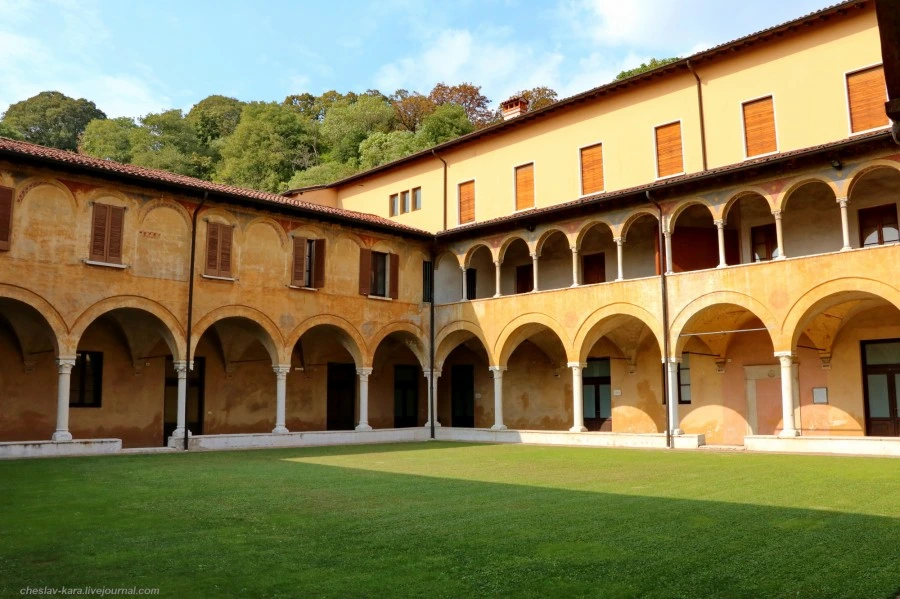
Inside, it is also decorated with magnificent frescoes made in the 15-16th centuries.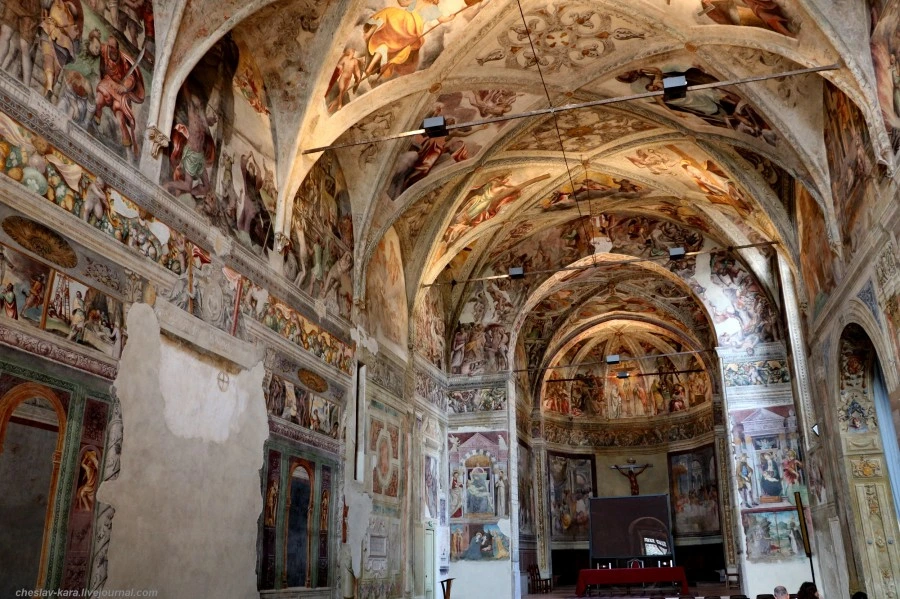
(I often repeat something about "magnificent frescoes", but what to do - as Ravenna is a "city of mosaics", so Brescia is a "city of frescoes").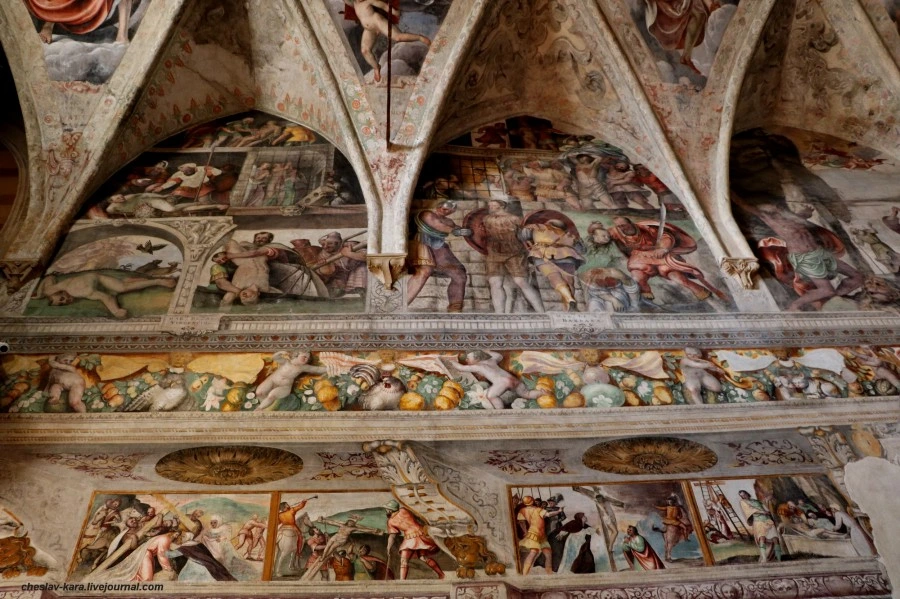
(don't forget to turn on the backlight by throwing a coin into the machine at the entrance).
Church of Santa Maria del Carmine ()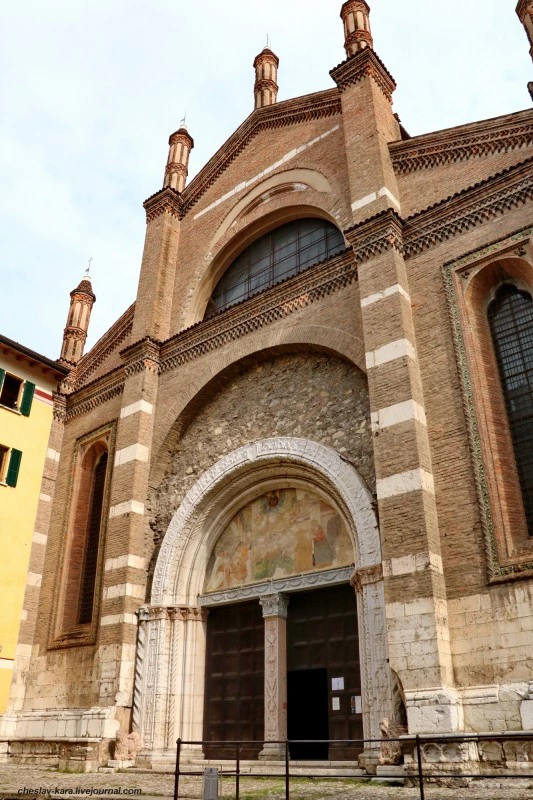
Inside it is also painted with wonderful frescoes: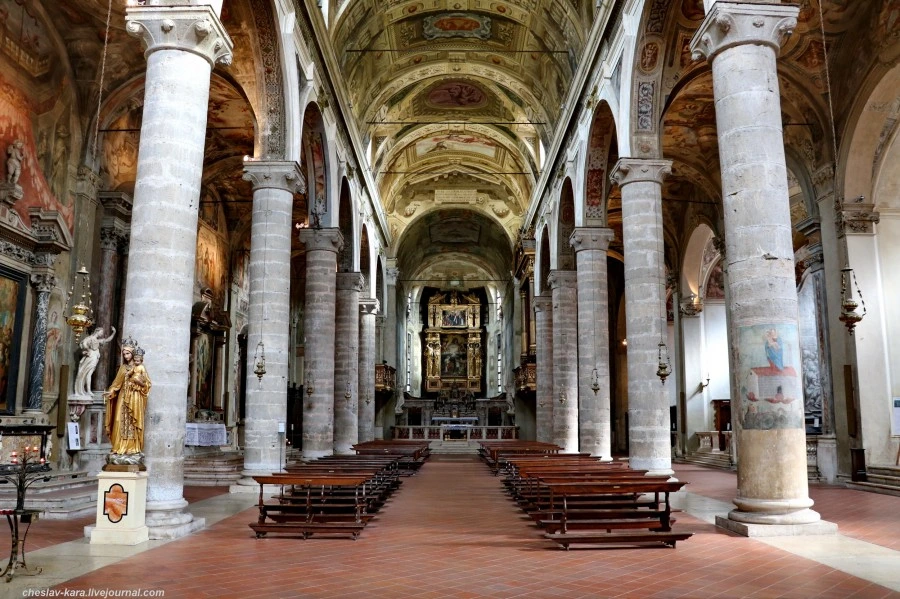
The original frescoes of the late 15th century have survived little, the existing ones were mainly executed in the middle of the 17th: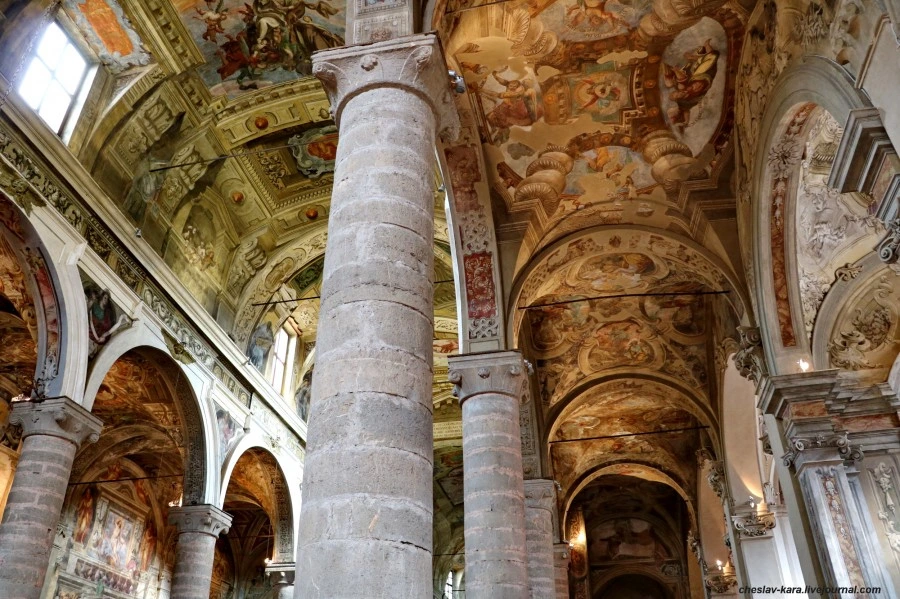
The small octagonal church of Santa Maria della Carita () does not look impressive: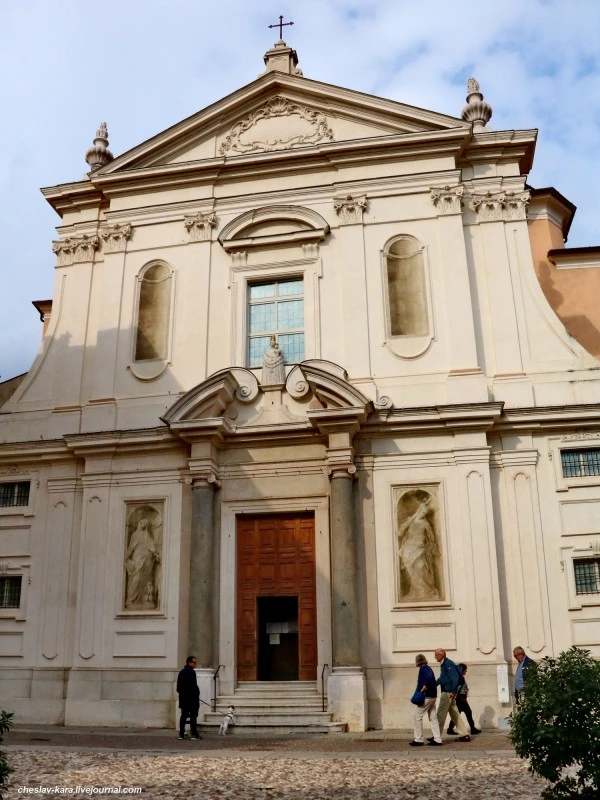
Inside - the unbridled riot of the Baroque: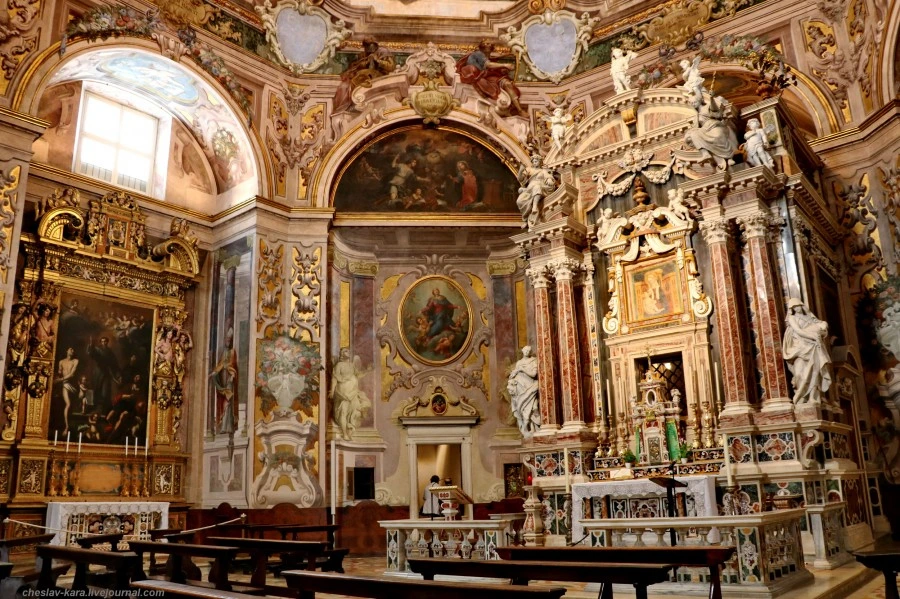
On a hill to the north of the city center is the Castello di Brescia fortress , also known as the Italian Falcon (). It is one of the largest surviving bastion fortresses in Italy. It was founded in the 13th century, subsequently expanded and rebuilt several times, following the development of military thought.
Above the entrance gate is the Venetian lion of St. Mark: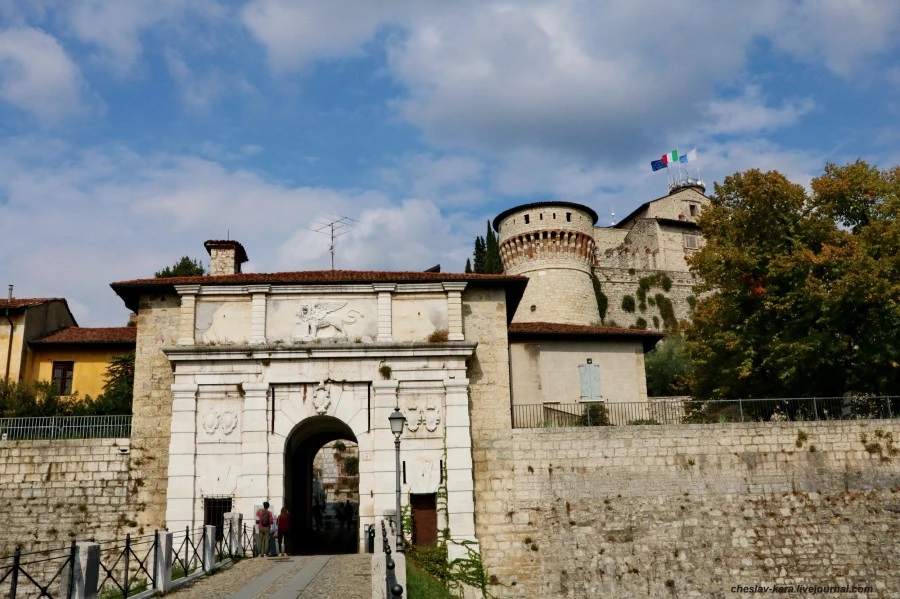
It was the Venetians who made the last major reconstruction of the fortress in the 16th century, adding 3 bastions from the south (from the side of the city). The central one is the Bastion of San Marco ():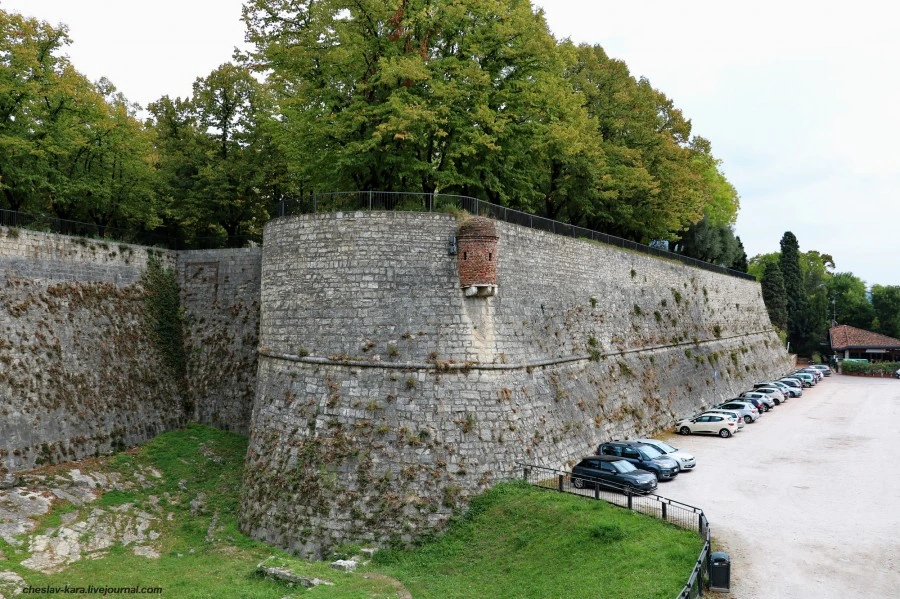
Prison tower (, "prisoners tower"). On the left you can see a drawbridge leading to the central, oldest part of the fortress.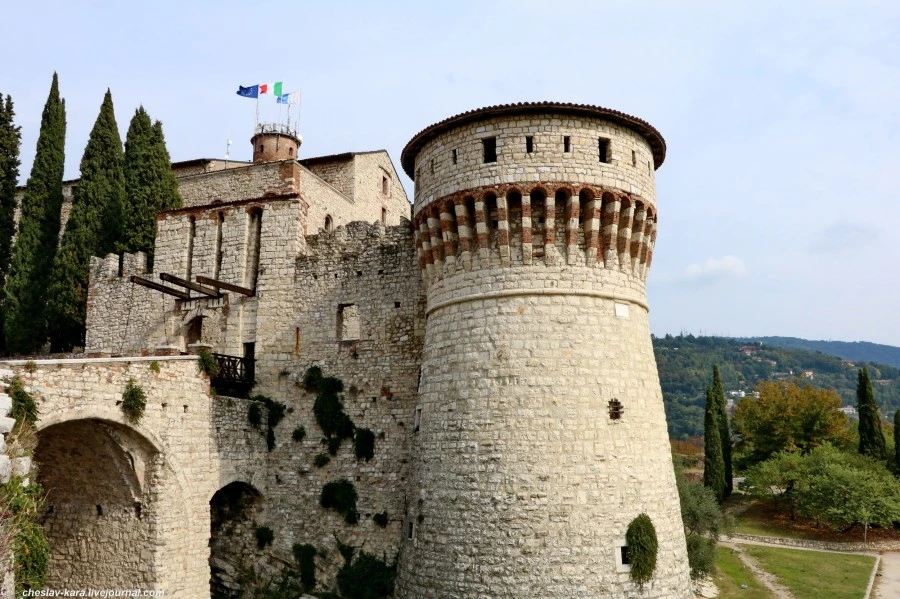
On the north side there is a steep cliff: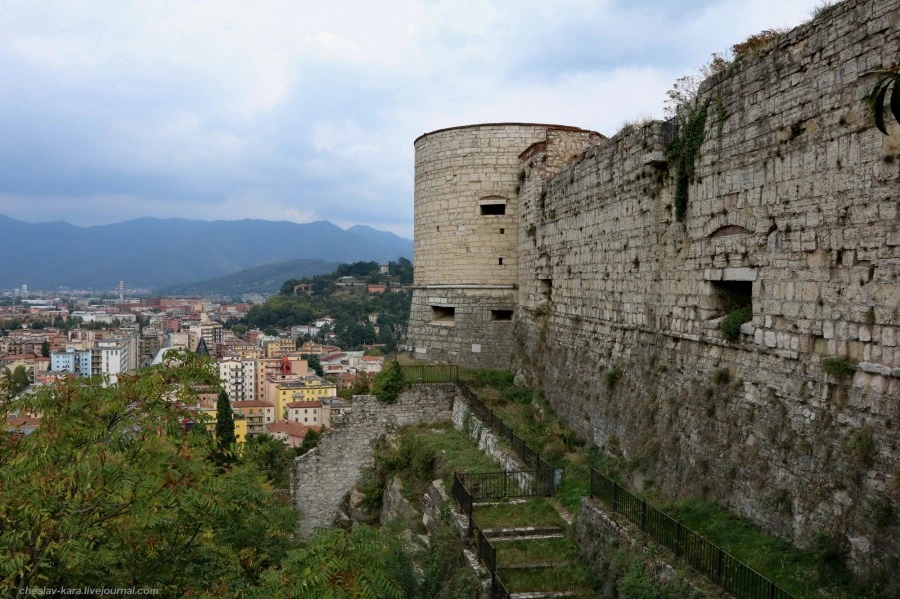
The center of the fortress is the Mirabella tower (). In the building behind her there is a small museum of edged weapons.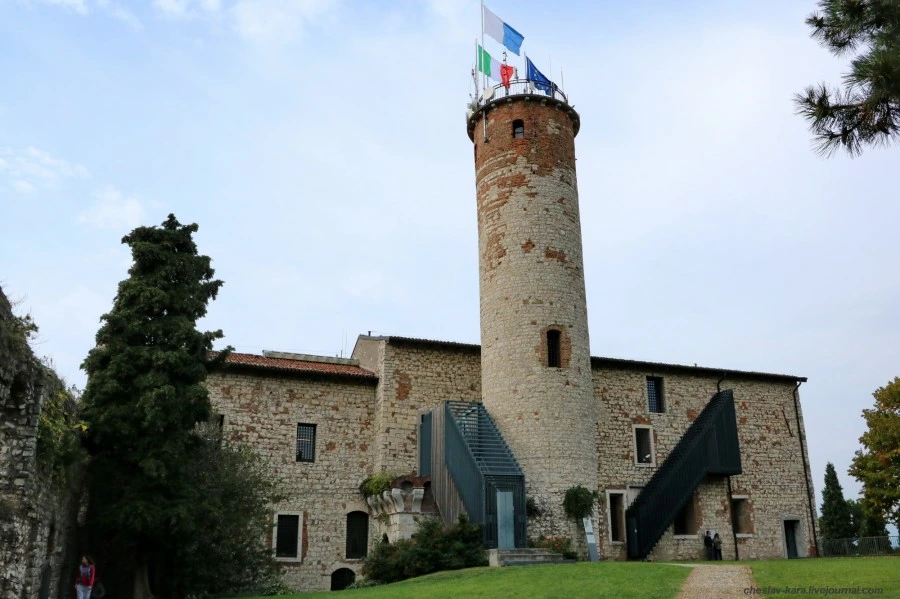
From the walls of the fortress, magnificent views of the city and the foothills of the Alps open: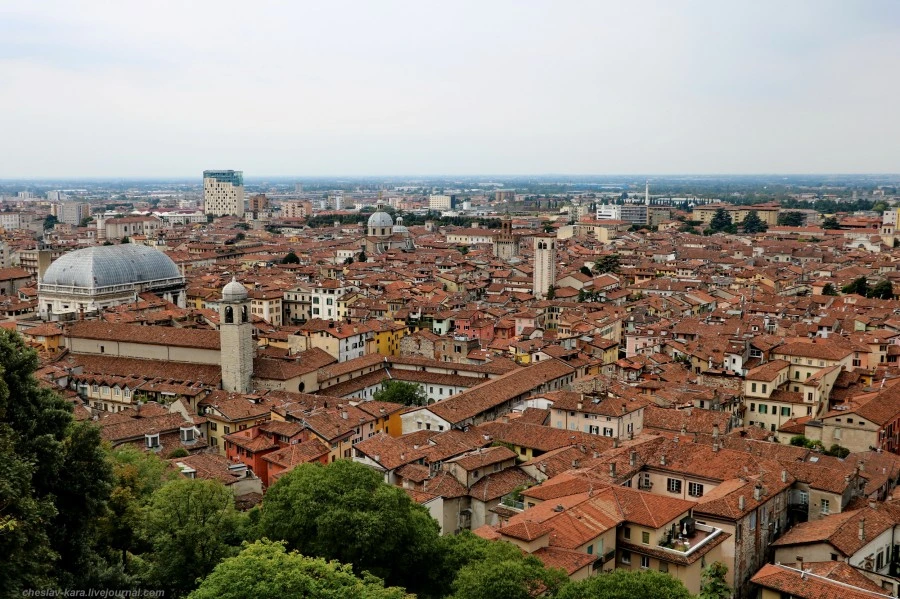
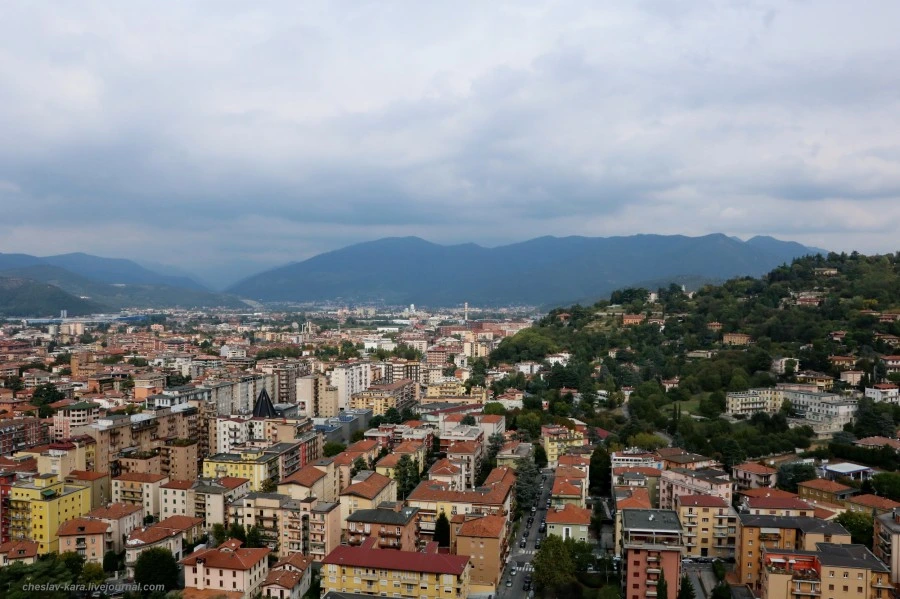
In addition to the churches that I have described, in Brescia you should definitely visit at least one more: Santa Maria del Grazie () - nondescript from the outside, it has a completely amazing baroque interior. Unfortunately, it was not possible to photograph him because of the festive service held there.
Address: Via delle Grazie, 13 (coord. 45.5426, 10.2135)
Also recommended for visiting the church:
- - in its altar part there is one of the masterpieces by Titian - the so-called. Polyptych Averoldi (Averoldi Polyptych).
- - wonderful ceiling paintings (and everything else too).
In general, if you are not indifferent to Italian art - welcome to Brescia!
By train from Verona 40 minutes, from Milan - just over an hour.
Articles in Wikipedia: rus., Eng.

Further 38 photos (October 2019):
Brescia was founded a long time ago, no later than 350 BC, flourished in the era of Ancient Rome, in the Middle Ages, like most northern Italian cities, the history had a turbulent history, often passing from one ruler to another. From the 15th to the 19th century, Brescia was owned by the Venetians. In 1799 it was taken by storm by the troops of Suvorov, but after the Napoleonic wars the city fell to the Austrians, who were heroically driven out by Garibaldi in 1859.
Now the population of Brescia is about 200 thousand people, it is the second largest city in Lombardy after Milan.
We start as usual from the station. Its building is stylized as a fortress:

Brescia has many churches with beautiful interiors. It is unrealistic to get around everything in one day, and there is no way to tell about everything in one post either. Therefore, alas, some attractions will have to be sacrificed.
The first church on our way is St. Francis of Assisi (). The building of the church and monastery was erected in the 13-14th centuries. As usual, the outside looks pretty simple:

Initially (in the 14th century) all the walls and ceiling of the church were covered with frescoes. Unfortunately, most of them have been lost, so that the interior at first glance seems simple and austere, as St. Francis bequeathed:

However, walking to the middle of the church and turning left, you can see a real gem in the Baroque style - (Chapel of the Immaculate Virgin).

Its interior belongs mainly to the 17-18 centuries.
There is also a small church of Santa Maria dei Miracoli () nearby . Here, attention should be paid to the stone carvings that adorn both the facade and the interior:


Typical streets of the historic city center:


Tower of Torre della Pallata . Built in 1254, later added a clock and a fountain in the form of two streams, symbolizing the main rivers of Lombardy - Mella and Garza:

Street Garibaldi (Corso Giuseppe Garibaldi):

The three central squares of Brescia are next to each other. The most modern of them, reminds of the times of Mussolini. Here, in particular, is the first skyscraper in Italy - Torrione INA . This 13-storey building with a height of 57 meters was completed in 1932 and was the tallest in Italy until 1934.
The arches around the windows were supposed to resemble the Colosseum, according to the architects:

The Renaissance is symbolized by the Piazza della Loggia (). It was formed in the 15-16th centuries, during the period when Brescia was part of the Venetian Republic.

The clock is very similar to the one installed in Venice in St. Mark's Square.

In the fashion of that time, the dial is 24-hour, in addition, they display the phases of the moon, calendar, zodiac and other relevant information:

On the opposite side of the square is the Palazzo della Loggia (). The palace was built for the city authorities in 1492-1572.

Despite the fact that this is a functioning administrative building, in principle, you can go inside (unless there are any official events held there) and admire the wonderful interiors.
The third of the central squares is Piazza Duomo (aka)

On the right, you can see the tower ("People's Tower") and the palace (a complex of buildings of the 12-13th centuries used by the city administration).
There are two cathedrals (Duomo) - New and Old.
The construction of the new Cathedral (aka) began in 1604, and was finished only in 1825. It is, of course, large, impressive, but - some boring one. Both outside and inside, it is made in one and only color - white.

Nearby is the Old Cathedral (), also called because of its round shape. Built in the 11th century on the site of an early Christian basilica.

Inside, the Old Cathedral consists of two very dissimilar parts. The first is round, completely devoid of any decorations, in the austere spirit of early Christianity:

At the back, a rectangular transept with an altar and two chapels on the sides, built in the 14th century, adjoins the round rotunda.

And this "rectangular" part of the cathedral is richly decorated with Baroque works of the 16-17 centuries:

Go ahead.

In Brescia, the ruins of the ancient Roman Capitoline temple () and a theater () are preserved :

The entrance to the Capitol is paid, the theater is free.
Behind these ruins, a little further along Via dei Mesei, on the territory of a former monastery, there is a museum complex. It includes the archaeological and art museums, as well as one of the pearls of Brescia, the Church of San Salvatore (UNESCO World Heritage Site). The choirs of this church are painted with beautiful frescoes. Being in Brescia, you must see them MANDATORY.
Alas, that day there was a concert in the church and it was not possible to get inside ...
As a consolation, you can go up the side street (Via Giovanni Piamarta) to the Chiesa di San Cristo church :

Inside, it is also decorated with magnificent frescoes made in the 15-16th centuries.

(I often repeat something about "magnificent frescoes", but what to do - as Ravenna is a "city of mosaics", so Brescia is a "city of frescoes").

(don't forget to turn on the backlight by throwing a coin into the machine at the entrance).
Church of Santa Maria del Carmine ()

Inside it is also painted with wonderful frescoes:

The original frescoes of the late 15th century have survived little, the existing ones were mainly executed in the middle of the 17th:

The small octagonal church of Santa Maria della Carita () does not look impressive:

Inside - the unbridled riot of the Baroque:

On a hill to the north of the city center is the Castello di Brescia fortress , also known as the Italian Falcon (). It is one of the largest surviving bastion fortresses in Italy. It was founded in the 13th century, subsequently expanded and rebuilt several times, following the development of military thought.
Above the entrance gate is the Venetian lion of St. Mark:

It was the Venetians who made the last major reconstruction of the fortress in the 16th century, adding 3 bastions from the south (from the side of the city). The central one is the Bastion of San Marco ():

Prison tower (, "prisoners tower"). On the left you can see a drawbridge leading to the central, oldest part of the fortress.

On the north side there is a steep cliff:

The center of the fortress is the Mirabella tower (). In the building behind her there is a small museum of edged weapons.

From the walls of the fortress, magnificent views of the city and the foothills of the Alps open:


In addition to the churches that I have described, in Brescia you should definitely visit at least one more: Santa Maria del Grazie () - nondescript from the outside, it has a completely amazing baroque interior. Unfortunately, it was not possible to photograph him because of the festive service held there.
Address: Via delle Grazie, 13 (coord. 45.5426, 10.2135)
Also recommended for visiting the church:
- - in its altar part there is one of the masterpieces by Titian - the so-called. Polyptych Averoldi (Averoldi Polyptych).
- - wonderful ceiling paintings (and everything else too).
In general, if you are not indifferent to Italian art - welcome to Brescia!
By train from Verona 40 minutes, from Milan - just over an hour.
Articles in Wikipedia: rus., Eng.

